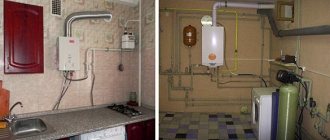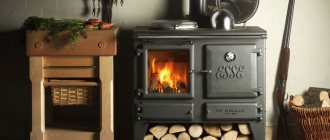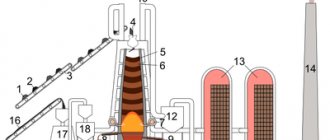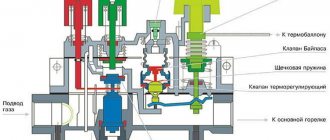It’s hard to imagine modern life without kitchen appliances - with their help we cook dinner, bake pies, store food, and treat ourselves to fresh coffee in the morning. And among the numerous equipment, the stove stands out, which at one time successfully replaced the hearth - the stove.
The population of gasified areas, living in low-rise and private houses, uses gas stoves. If this tireless assistant has also settled in your kitchen, we suggest you figure out how a gas stove works, what parts it consists of and how to increase its service life.
Our tips will help you take care of your equipment and react correctly if it breaks down.
What is often forgotten
Gaseous fuel has a remarkable property: its combustion rate can be arbitrarily high, even to the point of detonation.
They fight the danger of an explosion by adding a fragrance to household gas: the human nose literally smells mercaptan molecules, and the unbearable stench will force you to take the necessary measures, as physicists put it, many orders of magnitude before the gas concentration in the air reaches a dangerous value. In this case, something else is more important: with the correct design of the burner, the gas burns completely, down to CO2 and water vapor, within a few centimeters from the burner nozzle at any value of its supply. As a result, firstly, in a gas sauna stove you don’t have to worry about clogging the flow-through (open) heater with soot and soot.
Secondly, a gas furnace for heating a house is capable of maintaining maximum efficiency of up to 5% and even 3% of the nominal power; For solid and liquid fuel stoves, when the power drops below 10-15% of the nominal value, the efficiency drops sharply. Since in mid-latitudes during the heating season the heat loss of a building varies depending on the weather by more than 10 times, the savings in fuel heat equivalent are almost double.
Thirdly, the risk of burning decreases sharply. Carbon monoxide, carbon monoxide, has no odor, and the first symptoms of poisoning appear when it is quite severe. Fragrance - mercaptan burns more difficult than saturated hydrocarbons, and if the fuel does not burn out, its smell will make your eyes water long before the fumes begin.
Placement of a gas heating device
A gas furnace can only be installed in houses in which the air ducts have been properly installed in advance . They must be strictly vertical .
Attention! Never install the structure close to a wall . The acceptable value is at least 50 centimeters .
It is prohibited to use wood or linoleum as a base It must be smooth, hard and non-flammable . In addition, depending on the size of the stove, the base should exceed it by at least 10-15 cm on each side .
The placement of the device in the house is influenced by its power:
- Installation takes place in the kitchen , if this figure is not more than 60 kW .
- In case of excess power ( more than 60 kW ), installation is permissible in a separate room or annex.
It is not allowed to place such stoves in houses whose walls do not reach two meters in height.
Stove with gas oven for cauldron and bread and its features
In most cases, the portable kiln is the main competitor to existing heat sources and kiln and cauldron designs. It is difficult to compare this functional device with a wood-burning stove or any other solid or liquid fuel.
Simplicity is the main difference between this unit during operation. In warm weather, it will take no more than 2 hours to warm up, and in winter it will take a maximum of 4-5 hours to achieve the desired temperature.
For a kitchen deck gas stove with oven, certain rules must be followed regarding the boiler installation process. The approximate service life is no less than 25 years, and if preventive and repair work is carried out in a timely manner, the stove will last at least twice as long.
If you can visually imagine the elements that make up the basis of a portable kitchen stove with an oven that runs on wood or any other liquid and solid fuel, then not everyone can understand the design of a gas stove. This requires certain skills and experience. But this is not a problem - you need to understand the features. Gas portable oven for heating your home, kitchen or baking bread, includes the following elements:
- A protective case that eliminates worries about the internal contents.
- A fuse that ensures that gas supply is interrupted in the event of a failure. It should be noted that the system using firewood does not have this capability.
- Responsible for thermal properties is the thermostat.
- The sealed chamber of the hearth oven, on the integrity of which its own safety depends. During the selection and acquisition process, you need to clearly monitor this.
- The chimney is a part of the structure that ensures the removal of combustion products. In addition, it is also a source of heat.
Despite the rather harsh conditions related to the use of gas in everyday life, ceramic kilns that operate on this fuel are widespread and safe. The main feature is functionality and low costs during use. In addition, such devices are more environmentally friendly than their wood-burning counterparts.
Thanks to this equipment, the room warms up as quickly as possible, and the degree of heat retention depends on the time of year and the outside temperature. Thanks to high-quality and uniform heating, comfortable conditions are achieved in any room.
A gas portable sauna stove is practically no different in design from similar devices, but still has a number of features. First of all, this concerns the type of fuel used. In such devices, in addition to the thermostat, a fuse is required that trips when the burner goes out and the gas supply stops. The fuel combustion chamber is located directly under the heater, which allows for rapid heating of the stones.
For gas firing devices, as well as for wood burning devices, a chimney is required to remove combustion products. Such stoves provide the best steam in the sauna, quick heating of the heater and the steam room itself. Thanks to the even distribution of heat, a stable temperature is ensured.
Electrical control and monitoring system
The cheapest stoves do not have electronic control - the entire process is controlled mechanically . In more expensive models, an electrical system is connected to enable the electric ignition and lighting , as well as spit control .
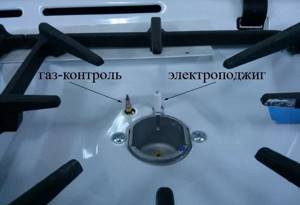
The design of electric ignition plates includes candles located on the divider body. They instantly fire when turned on, that is, at the moment the gas escapes
Some users are so accustomed to the auto-ignition system that they get lost when the power goes out and don’t know how to turn on the gas. This is done simply: the control knob must be placed in the working position, and then a lighted match must be quickly brought to the divider.
The backlight function works differently: in some ovens it turns on by pressing a button, in others it turns on automatically, every time the oven is turned on.
Gas control, which is operated by a thermocouple, is very useful.
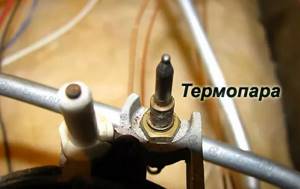
The main purpose of the thermocouple is to shut off the gas supply if the burner flame goes out for any reason. Operating principle: the fire disappears, the temperature drops sharply, the gas is automatically shut off
The most expensive models are equipped with electronics, which facilitates both the cooking process and equipment maintenance.
Using a panel with buttons and a display, you can control all processes, which may include the following:
- timer;
- delayed start;
- steam oven cleaning;
- several cooking modes;
- light and acoustic alarm;
- electronic temperature control;
- rapid cooling system, etc.
If the stove is inexpensive, but equipped with electronics, you should ask yourself the question: how often will you have to contact the service center? Because, according to statistics, electronic equipment breaks down much more often than conventional equipment.
Buy or make?
The first thing you need to know if you are interested in gas stoves is that homemade gas appliances are not certified by the Ministry of Emergency Situations; their use is expressly prohibited. At the same time, buy a good gas stove for constant heating of 1 room up to 120 sq. m of domestic production is possible for an amount equivalent to 800-950 US dollars. A “firm” will cost 50-150 USD more, but this is money “for a star”; the quality of Russian gas appliances is recognized all over the world.
A mobile gas heater with a power of up to 12-15 kW costs up to 350 USD; you can find a good certified one for 150 USD. Separate heating elements (more details below) for 8 sq. m of constantly heated area costs about 100 USD, i.e. a heating system for an average-sized house will cost less than 1000 USD, including installation of pipelines and fittings.

Gas burner for heating and cooking stove
Can I do this work myself? No, only certified specialists are allowed to work with gas. The contracting company itself will draw up all the documents for gas heating. This, together with the work, will cost about another 600 USD, which is still much cheaper than building a wood-burning stove that heats 1-2 rooms.
You can gasify an existing stove with your own hands by purchasing a special stove burner for it (see figure) for 200-250 USD (in rubles). Such burners are equipped with an automatic system that shuts off the gas when the flame goes out, the stove and surrounding air overheat, gas leaks, etc. More expensive models are equipped with automatic ignition.
Gas stove burners are supplied with a certificate of suitability (don’t forget to ask the seller!) and are sold as separate devices. They are installed in the opening (creation) of the firebox and do not require alteration of the stove. Thus, a gas-wood stove is obtained.
All of the listed parameters and features, with proper selection and further operation, will provide heat to the available areas, as well as eliminate the use of an electric oven. It is worth paying attention to the fact that any gas systems have detailed instructions, so you can do all the work yourself, without the involvement of specialists.
Thanks to this, the owner will be fully familiar with the available technical characteristics and internal contents, and will also be able to save significant money. After completing the work, it is better to invite a qualified stove fitter to make sure it is safe to use.
Conversion of the gas unit
You can make wood-burning boilers with your own hands not only from scratch. In the vast expanses of the Internet you can find not only diagrams of homemade boilers. If you still have an old gas boiler, you should not throw it away or recycle it.
To do this, the boiler must be disassembled and all elements that must be connected to the gas system removed from it. Next, it’s worth turning to the diagram of a homemade boiler. There is nothing complicated in such a scheme. The converted gas boiler system is similar to an antique steam locomotive.
This boiler consists of a metal barrel that is filled with water. Pipes are laid inside the barrel and brought out. Through these pipes, heated air enters the heating system. Air circulation is carried out in two ways: natural and forced. The use of forced air circulation in a garage heating system is irrelevant. Such heating schemes are suitable for two-story residential buildings. For a garage, it is quite enough to implement a simple heating system with natural circulation of coolant within the system.
The heating system itself and radiators are mounted to those pipes that extend from the water tank. To heat a regular-sized garage, it is enough to equip the heating system with just two radiators of 4 sections. Considering the fact that this room will be heated periodically, you should not use water as a coolant. The best option for such heating systems is air or antifreeze. Antifreeze is quite expensive, so it is better to opt for an air heating system.
Any solid fuel whose humidity does not exceed 20% can be used as fuel in such boilers. The most common and inexpensive fuel is wood. At enterprises that cut wood, you can purchase scraps of boards or formwork for a low price. Thus, an old gas boiler can be turned into a quite useful tool for heating a garage space.
Which stove is suitable for gas?
Natural gas, as already mentioned, burns very quickly and produces a lot of heat. Brickwork is simply not able to immediately perceive and transmit such a flow into the room; a gas burner is an instantaneous device, and a brick oven is a heat accumulator. Therefore, only metal furnaces are clearly suitable for gasification; their efficiency with gas increases. If you still want to gasify your grandfather’s stove, then the brick gas stove must satisfy the following conditions:
- Without an extensive combustion chamber and massive masonry, a Russian stove is no longer needed.
- The stove must be made according to a duct design with a developed smoke circulation system, Dutch or Swedish.
- All heat release must occur in the firebox, i.e. all bell-type stoves without exception are eliminated: natural gas is too energetic for them, the exhaust gases from under the bell arch will be forced out into the chimney without having time to transfer heat to the body of the stove.
In any case, accelerating a brick kiln on gas requires a very long time, 4-6 days. During this period, the gas supply is gradually increased from minimum to nominal. Hence the corollary: it makes sense to gasify a brick oven only if it will be heated continuously for a long time. But what kind of masonry is needed that can withstand constantly large amounts, over 450 kW/cu. m, thermal stress?
Chimney construction process
The complexity of the process of constructing a chimney for a potbelly stove in a country house directly depends on the location of the stove in the room. For example, bringing a pipe out through a window is much easier than making a hole for a chimney in the roof. In this regard, before installing a potbelly stove, you should take into account the design features of the building.
Safety rules and structural measurements
If you plan to install the stove outdoors, then installing a chimney will not cause much difficulty, the main thing is to choose a suitable location
It is important to remember that the stove structure should be located away from flammable objects and active recreation areas
Constructing a chimney indoors will require knowledge of safety rules that will help avoid fire. The material from which the pipe is made must have increased heat resistance and can easily withstand temperatures above 1 thousand degrees. If you plan to install a potbelly stove near walls lined with clapboard or plastic, then the part of the wall located in close proximity to the stove is sheathed with fireproof material.

Don't forget to decide on the pipe size
The hole through which the chimney will enter the ceiling must also be decorated with non-combustible materials, since the entire structure becomes very hot when the stove is operating. For these purposes, a special glass is used to prevent contact of the hot pipe with the edges of the hole. If there is more than one potbelly stove installed in a building, then a separate smoke exhaust system is made for each of them.
After calculating the diameter of the pipe for the potbelly stove, you will need to calculate the total length of the pipeline, but first you need to accurately determine the location of the stove in the room. Then determine the specific location where the chimney will be vented outside. When measuring the length of the pipeline outdoors, you need to take into account that the height of the pipe above the ridge should be 1.3-1.7 meters.

It is more difficult to carry out installation work indoors
Installation of all system elements
Installing a stove installed outdoors is not difficult. To assemble the system, you will need a pipe of the required diameter, which is placed on the pipe extending from the potbelly stove. The pipe must be put on the pipe, and not inserted into it. Otherwise, smoke will leak out at the junction of the nodes. The procedure for installing a smoke exhaust system in a room is much more complicated and consists of several stages:
- the pipe section is securely attached to the furnace pipe;
- the pipeline is extended using connecting elbows;
- the smoke exhaust is passed through a passage glass and discharged onto the roof or behind the wall;
- all connecting nodes are securely fixed.
A section of pipeline located outdoors must be insulated with heat-resistant material. During operation of the potbelly stove, condensation inevitably accumulates on it. To get rid of the condensate accumulated in the system, a tee is installed on the outer section of the pipeline, equipped with a faucet for discharging liquid. In the place where the horizontal and vertical pipelines connect, an inspection window is made to make cleaning the chimney easier.
The final stage is checking the functionality of the smoke exhaust system. If you managed to properly make a chimney for a potbelly stove, then after igniting the stove the necessary draft will be created and the smoke will quickly be discharged outside. During the combustion process, you need to ensure that smoke does not leak into the joints of the nodes. If a smoke leak is detected, the connections must be sealed using heat-resistant sealant.
Do-it-yourself gas stove for baths
For example, let's consider the possibility of making an infrared muffle oven for the kitchen and baking bread with your own hands, which will run on gas. This option can even be used for melting various metals, firing or cauldron, since the firing temperature can reach 1400 degrees.
The basis of the furnace is the body and the burner. To make a gas burner, you will need a small piece of pipe with a diameter of no more than 2 cm and a length of about 15 cm. On the external thread side, you will need to drill a certain number of holes, the first of which (from the edge of the pipe) must be through. It is necessary to place the gas supply tube.
The next three holes should be away from the edge. Their main purpose is to ignite the burner and take in air. The through hole used for the gas supply tube must be clearly perpendicular to the three holes. For the gas supply pipe, a copper pipe is used, the diameter of which is approximately 0.8 cm.
There must be a thread at both ends, and in the center there must be a blind hole necessary for releasing gas. A plug is screwed onto the thread on one side using fum tape. On the other hand, an angle with external and internal threads is placed, to which a hose coming from the gas cylinder is subsequently connected.
To avoid turning the gas supply tube in the burner, it is necessary to make a small cut on the side, which is necessary to secure the burner with a tightening bolt. An important point is that when connecting the gas hose and the burner of the deck oven, it is necessary to install a fire barrier valve to ensure complete safety.
Burners are:
- Atmospheric.
- Supercharged.
For a homemade design, you can only use forced-air burners. They are more complex than atmospheric ones, but much safer.
The devices are equipped with automatic valves that will shut off the gas if the flame goes out, or the stove overheats, or if there is a leak. There are models with automatic ignition.
You need to purchase a burner in advance, before stocking up on all the materials. The fact is that burners come in different sizes and shapes - drawings and diagrams will be developed based on this.
What you need to prepare to build a gas sauna stove:
- Atmospheric burner.
- A gas cylinder (not old), or a pipe with a diameter of 50 - 60 cm, or metal 8 - 16 mm thick.
- The base of the heater can be made from a car brake disc; very thick metal will not burn out for a long time.
- Two gas pipes of 50 mm diameter.
- Pipe 100 mm in diameter for gas removal.
- Copper or bronze connecting elements.
- Tools (welding machine, grinder, drill, plumbing, measuring tools, etc.)
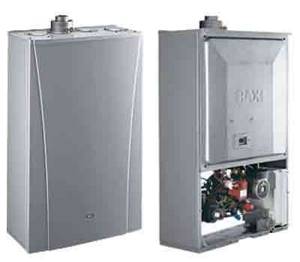
The edge of the cylinder is cut so that the cut diameter matches the external size of the brake disc. The disk is attached using welding or bolts.
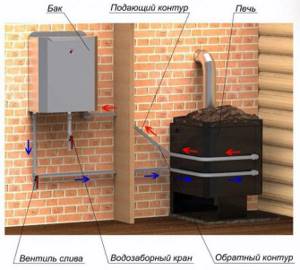
Gas furnace device
A pipe is made that will supply air to the combustion chamber. Several holes (about 10 pieces) are drilled into the pipe section, after which a place is prepared for it in the lower part of the furnace body. The hole in the housing should be slightly larger than the diameter of the tube. It is welded so that the edge without holes protrudes outward from the cylinder by about 20 cm.
Everything needs to be done especially carefully when working with the pipe that will supply gas. An adapter is installed at one end, connecting the pipe to the gas source, and the second is welded into the furnace next to the air pipe.
Further steps are exactly the same as when making a regular boiler. A chimney pipe is welded into the upper part of the cylinder (it must be solid, without seams).
At the owner's request, legs can be installed. Fill the heater.
Getting steam from a gas heater is more difficult than from a wood-burning one. It takes longer to heat it, and you need to choose stones more carefully, with good heat capacity.
A gas heating stove can either be assembled with your own hands or purchased in a ready-made, assembled state in a specialized store. Each of these options has its positive and negative sides.
Basic moments:
- It is strictly forbidden to use homemade gas equipment and devices in accordance with the safety rules prescribed by the Russian Ministry of Emergency Situations;
- The cost of high-quality, powerful heating equipment capable of heating a large house is about 800 dollars or more;
- The most budget-friendly, at the same time very high-quality, functional devices are domestically produced;
- An affordable, but less powerful option is mobile units, which have small dimensions and appropriate weight, allowing them to be moved from one room to another and transported.
The gas stove has a visual similarity to classic wood-burning fireplaces
The firebox can be framed in the required color and style
Methods of supplying gas to the stove
There are two ways to gasify a bathhouse:
- From the citywide system.
Individually using a balloon.
Gasification from the city system
Gas can be supplied to the bathhouse from the city pipe. If a gas pipe runs through the area, then it is more profitable to power the bathhouse from it. Let’s say right away that this is a labor-intensive task and requires knowledge and permissions. The price for the services of specialized companies is high, but once you supply gas to the bathhouse, you won’t have to worry about it for many years. And paying gas bills will be less expensive than purchasing bottled fuel each time.
For urban gasification it is necessary to carry out a number of measures:
- Receive and approve a number of documents: gas supply project, agree on technical conditions and draw up an estimate.
Purchase equipment and pipes and carry out installation.
Prepare test and technical documentation and submit the work to the local gas service.
Enter the system, install and register the meter, start it up and receive documents for maintenance and fuel supply.
It’s difficult to do all of the above points on your own; it’s easier to call a specialist. Moreover, the city gas company itself will provide and conduct pipes to the heating device.
Individual gasification
You can power the stove from a gas cylinder, which comes in different sizes. Individual gasification is suitable for areas where there is no city line. A gas cylinder can be purchased at any specialty store. But such gas supply is quite unsafe.
Safety comes first, the cylinder should not be installed in a bathhouse, its place is outside. The place chosen is easily accessible and ventilated, that is, the cylinder cannot be filled with various objects or covered with things. A fire extinguisher is hung nearby or a small box of sand is installed.
What do you need besides money?
First of all, you need to check whether the burner certificate is valid. The easiest way to do this is to make a copy of it and show it to the gas service inspector. He can also advise in advance which model is better to take. The burner power for a sauna stove is calculated based on the value of 1.5 kW per 1 cubic meter. m to warm up the steam room to 80 degrees (where did the 252 kcal/0.4 cubic m circulating on the RuNet come from? To make it inconvenient to count, or what?); for household - according to the thermal engineering calculation of the building or taken equal to the power of the existing stove.
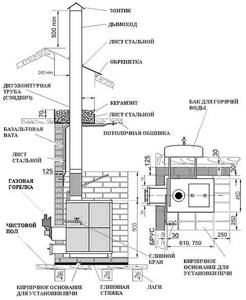
Gas sauna stove installation diagram
Next, you need to check your stove: the firebox opening must have a metal frame. The dimensions of the opening itself are height 470-550 mm, width 350-450 mm; together with the overlay, 615-680 mm and 515-665 mm, respectively. Then - the room. Installation of a gas stove is allowed in rooms with a volume of at least 8 cubic meters.
m with a ceiling height of at least 2.2 m. In a room with a stove there must be an opening window at least 60 cm wide, with an area of 0.6 sq. m, and the gap under the door is at least 40 mm for air flow. Instead of a gap, there may be a ventilation grill on the door. The distance from the stove to the nearest wall made of flammable material is from 500 mm. Removal of the refractory base of the furnace is from 100 mm in any direction.
For a bathhouse, an additional condition applies: the firebox door should not open into the washing room or steam room. Therefore, the fireboxes of gas sauna stoves (see below) are made elongated so that the door opens into the dressing room. So keep in mind that it’s better not to even think about gasifying a potbelly stove with a heater standing right in the steam room.
Construction
Before starting work, it is necessary to prepare all materials and select a furnace model with a serial construction scheme. In addition to a set of bricks and masonry mortar, you need a grinder with a disc for stones, since many bricks will have to be divided into parts.
Selection of bricks for various oven elements
If you have a limited budget, you can use ordinary ceramic bricks of average quality. You will still have to purchase a couple of dozen good refractory bricks or fireclay for laying the combustion chamber. A simple red brick will do for all sections of the smoke duct, and for the base (bottom row) you can also use used material. The use of hollow or silicate products is not permitted.
Choice of solution
For masonry, you can use traditional sand and clay mortar. The clay dissolves in water for a couple of days, after which, gradually adding water, it is used to make a liquid base for the solution. Pre-sifted sand is added to it (two parts to one part clay). The main requirements for the resulting mixture: the consistency of thick sour cream and maximum homogeneity. It should slowly slide off the trowel and not spread over its entire surface.

Construction supply stores offer a large assortment of ready-made cement-based masonry mixtures, enriched with chemical additives that increase uniformity and strength. You just need to purchase a package of this composition and fill it with water according to the instructions on the package. In our opinion, this is the best option.
Foundation
A brick oven needs a solid foundation, most often in the form of a concrete pad. It should protrude beyond the stove by at least 10 cm along its entire perimeter.
Direct connection of the building foundation to the base of the furnace is strictly prohibited. They should be separated by at least half a meter of sand or stone embankment.
In dense soil, a hole half a meter deep is enough. Its bottom is covered with wet sand and compacted. Then add a layer of crushed stone or brick fragments (about 10 cm thick). All this is poured with a mixture of cement, sand and crushed stone, mixed in a ratio of 1: 3: 5 and carefully leveled. When pouring the base, do not fill the hole to the top with mortar, but leave a thickness of one brick free.
Advantages of a deck gas oven
This infrared design for the kitchen, cauldron, baking bread or firing ceramics has a number of advantages that distinguish and influence wide popularity, in contrast to the electric model.
The most important positive quality that gas stoves for summer cottages and cauldrons have is efficiency, even if you use a cylinder. This is due to the relatively low cost of gas and the degree of its availability.
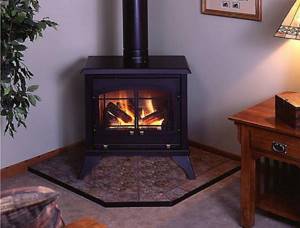
You can save significant money on maintaining a gas-powered deck oven when compared to an electric or solid fuel model. Equipment that runs on gas does not require excessive attention and is quite easy to use, unlike the electric model. There is practically no soot and ash in such an apparatus; the chimney and firebox practically do not need to be cleaned. There is no need to talk about durability, since it is difficult to find an analogue in terms of service life.
Is there any danger?
Many people associate gas stoves with direct danger and to a certain extent they are right. The fact is that liquid gaseous fuel can burn at a certain speed. If the burner is not designed correctly, it may leak, which is dangerous to human life and health.
Gas stoves for summer cottages with a cylinder are also included in the dangerous category. However, in order for the operation of such a heating unit to be as safe as possible, liquid fuel is odorless, but for safety reasons a small amount of a characteristic fragrance is added to it.
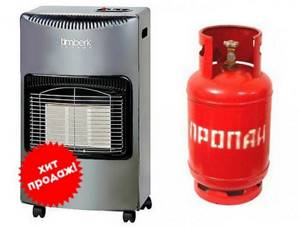
Heating equipment can be connected to a boiler or pre-installed communications
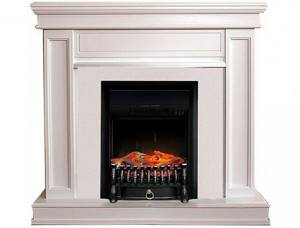
As an alternative to a gas fireplace, you can use a more affordable and easy-to-install electric one.
Important: gas stoves for a summer residence will be completely safe to use if the burner is designed according to all the rules and is fully operational. In this case, the gas will burn completely under any operating mode or supply intensity. Also, soot and soot will not form or settle in the inside of the burner.
Interesting to know: gas stoves are also highly economical. They are suitable for any conditions, their operation is allowed even at medium latitudes. At the same time, the efficiency of such fireboxes increases to the maximum, in contrast to solid fuel brick stoves, the efficiency of which decreases by 8-15 percent.
Gas stoves for home use are very popular among summer residents, as they are able to heat a small space well. At the same time, the gas itself, due to the fragrance called mercaptan included in its composition, allows you to sense something is wrong in time in case of a leak. This component causes lacrimation, has a pronounced, characteristic odor, and is safe for health.
To end the baths
Among the household stoves that go on sale, gas bath stoves are perhaps the most popular product, so you need to add something about them. Namely: a gas sauna stove is definitely suitable for a sauna with absolutely dry steam; It’s difficult to steam in a bathhouse with such a Russian-style stove, with a birch broom and topped up with kvass.
The reason is the same too rapid combustion of gas. A gas burner, without blazing into the pipe in vain, is capable of “burning” the heater properly at the rate of 6 kg of river pebble per 1 cubic meter. m of steam room, and for vigorous Russian steam you need at least twice as much stone. Experienced manufacturers (Termofor, Tulikiivi, eg.
Secondly, this is already a domestic idea, the heater is made double: the main large heat-accumulating one is closed and the smaller one is open specifically for adding heat; The diagram of a gas stove with a double heater and its appearance are shown in Fig. The configuration of the convector (it is needed to speed up the heating of the bath), the size and location of the holes in it are precisely calculated.
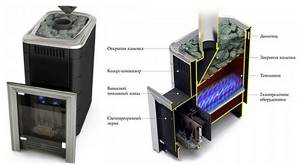
Modern gas sauna stove with double heater
You can add heat to such a heater made of ordinary stone about once every half hour, and only with water. Restrictions are also imposed on the broom: only birch and only dried. Adding kvass and steaming with a freshly cut birch broom turns out to be a bit difficult even for a strong, non-drinking man, but it’s probably better not to experiment with an oak broom even for the heroes.
Sauna basket stove
The second possible option is to gasify the basket heater like “Vesuvius”, see fig. on right. However, the heating time of the bath will remain “wood-burning”, and the gas supply, so that the heat does not waste away into the pipe, will need to be smoothly and gradually increased from the minimum to about 0.7 nominal over 1-1.5 hours.
Heating appliances using wood
If you use a wood-burning garage stove with your own hands, there may be several options.
Note!
- Do-it-yourself garage doors - a detailed description of the construction of various types of garage doors (120 photos)
- Insulate the foundation with your own hands - a step-by-step description of the use of the best materials and technologies (90 photos)
- Laying laminate flooring with your own hands: a detailed description of how to lay laminate flooring. Laminate calculation, step-by-step description and installation secrets (105 photos and videos)
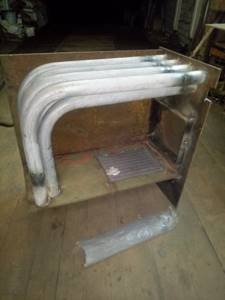
A wood-burning stove with a direct chimney or, in common parlance, a “potbelly stove.” The cheapest and easiest to install option. The disadvantage is the uneven heating of the garage area.
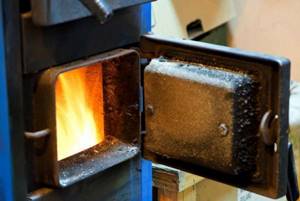
Which oven is better?
So, since we are talking about gas, you still need to buy a stove. In this case, naturally, we need the best gas furnace. How to choose it? Popular rumor, that is, consumer ratings, is essentially true, but it would be strange if advertisers did not gradually try to use such a powerful tool for promoting goods in the interests of their customers.
Quantity
In this case, this concept refers to the efficiency of the furnace. To calculate it, in addition to your own initial data, you need to know the higher calorific value of the fuel, or its calorific value. For flammable gases used in everyday life, it is as follows:
- Natural gas in the Russian Federation – 34-38 MJ/cu.m. m; average – 36 MJ/cubic. m.
- Pure methane – 34.67 MJ/cu.m. m.
- Pure liquefied propane (density 0.51 kg/l) – 25.54 MJ/cubic meter. m
- The same, butane, density 0.58 kg/l - 28.61 kg/l.
- Propane-butane mixture summer (50%/50%), density 0.545 kg/l - 27.09 MJ/kg.
- The same, winter, 90% propane and 10% butane, density 0.517 kg/l - 25.85 MJ/kg.
Now let's determine the heat and fuel consumption. Let's take, for example, a country bathhouse with a steam room for two with a volume of 12 cubic meters. m (2x3 m in plan and with a ceiling height of 2 m). It will require 1.5 kW x 12 cubic meters. m = 18 kW of heat, or 18 kJ/s of heat flow from the furnace. Per hour - 18 kJ x 3600 s = 64.8 MJ of heat. Next, we assume that our bathhouse is gasified. Then an hour of bath procedures at 80 degrees will take 64.8/36 = 1.8 cubic meters. m of gas.
Here you need to take into account the fact that stove manufacturers give the gas consumption in them based on heating the steam room to 60 degrees; Doctors say that at higher temperatures, it is dangerous for women and children who are at least a little sick (including temporary malaise after yesterday and euphoria from recent libations).
So, at 60 degrees and the efficiency of the furnace at 100% gas, you will need 60/80 = 0.75 x 1.8 cubic meters. m = 1.35 cubic meters. Choosing a stove turns out to be generally simple: the closer the fuel consumption declared by the manufacturer to this value, the better the stove. You just need to remember to look in the specification for what volume of the steam room it is stated for, and bring it to 12 cubic meters. If it is stated that there is less than 1.35 cubic meters of gas per 12 cubic meters of steam room, it means that you are a swindler. Or he invented a perpetual motion machine, but he himself doesn’t know about it.
Now let’s check independently, according to popular rumor. For example, in the Russian Federation, the Termofor Urengoy stove is in 1st place with a decent lead from the rest. Perhaps because of the price of only 12,000 rubles? Let's look at the declared gas consumption for 12 cubic meters of steam room - 1.71 cubic meters. m/hour. We calculate the efficiency of Urengoy: 1.35 (theoretical ideal consumption) / 1.71 (real for this furnace) = 0.79 or 79% A very good and very similar indicator to the truth; It's probably worth getting this stove.
Roughly offhand
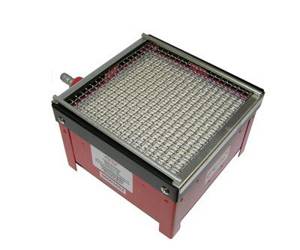
compact infrared gas heater
As for infrared gas heaters, which will be discussed below, their market and culture of use have not yet developed properly, and a unified method for determining efficiency has not yet been developed. These devices, unlike sauna stoves, are designed for long-term continuous use, so you need to somehow take into account the cost of heating and its reliability. Therefore, it is possible to choose more or less definitely only by comparison.
First, without worrying about dimensions and other physics, we multiply the “consumption” parameters: the hourly gas consumption stated in the specification by the cost of the device. Let's get a certain carelessly abstract value A. Then we multiply the “economical” indicators: thermal power by the duration of the company warranty in months; we obtain a similar value B.
The following is also nothing complicated: C = B/A. The higher C, the cheaper heating will cost. This is enough to compare different models, and you can calculate the exact cost of heating if you know the amount of heat required, the calorific value of the available gas and its consumption according to the specification for the selected sample.
Quality
It remains to understand such consumer parameters as reliability and functionality. The only possible way here is to compare popular rumor with the sales rating. The leaders in sauna stoves in the Russian Federation are the already mentioned domestic Termofor and the Finnish Tulikivi; for continuous infrared heaters - also domestic Bee Car and American Master.
Flaws
Gas ovens are not without their drawbacks. The equipment itself and its installation are by no means cheap. Natural gas, although the most inexpensive fuel, its cost in our country is systematically increasing.
Gas-fired stoves are quite difficult to install and connect. In the event of even the smallest mistake, you can encounter huge problems in using such devices (they either will not do what they are intended for, or will begin to pose a danger to the life and health of residents).
Rotary kilns
It is difficult to imagine the full-fledged operation of any baking or confectionery production without the use of equipment such as rotary or deck ovens. Such rotary kilns can be tunnel or hearth, differing in the type of activity, they are economical and easy to operate, which allows them to cope with large volumes.
Such an infrared portable stove can be either gas or electric (heating occurs thanks to heating elements or a burner). Rotary ovens are quite economical, and the automatic system with a clear and convenient touch panel allows you to set the start of work at a specific time. Existing locks greatly facilitate the work process and allow you to avoid unpleasant moments.
New quality of gas fuel boiler
From an economic point of view, it is advisable to use gas in cylinders for small and tiny steam rooms, for example, for a bathhouse on a trailer or a sauna in a fishing house.
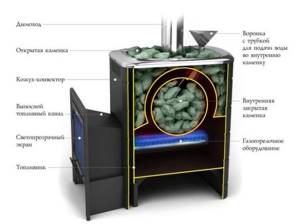
Using a gas boiler for a sauna or bathhouse allows you to solve several serious problems:
- Get rid of the fumes and the smell of scale that accompany almost all wood-burning stoves. Gas fuel combustion products consist of 99% harmless carbon dioxide and water;
- To ensure smooth and accurate heating of the air in the bathhouse, in many modern gas boilers for saunas the automation is able to maintain the temperature even more accurately than in the case of electric heaters;
- Get the desired compactness of gas equipment. A modern gas boiler is only slightly larger in size than an electric heater.
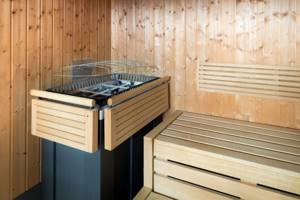
For your information! The temperature of the combustion front of methane fuel in the gas furnace of a boiler is only 850°C, while the intensive formation of deadly carbon monoxide and the release of fine soot begin at 1000-1100°C. For comparison, when burning firewood produces a flame 150-200°C higher than in the case of gas fuel.
This means that a branded gas boiler is much safer than any wood-burning stove. If you do not interfere with the operation of burners and control equipment installed by a specialized specialist, the chimney will remain sterile clean, and the risk of fire or poisoning is practically zero.
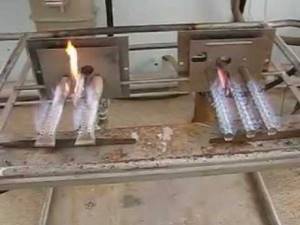
Gas stove revolution
This revolution is associated with the advent of gas infrared emitters, or infrared burners; both are designated by the abbreviation GII. There is a difference between them; which one - let's see below. For now, it is worth noting the fact: in terms of a set of parameters, including price, GII is ahead of conventional heating stoves, just like Porsche is ahead of the pre-war Emka.
For example, a 1.5 kW GII heats an area of up to 12 square meters. m, it weighs about 7 kg, and costs up to 5,000 rubles. Let us emphasize: this is not an analogue of an electric fireplace; we are talking about constant heating of residential premises. The price of a gigacalorie of heat turns out to be 1.5-2 times lower than from any other source. In addition, household gas stoves based on GII turn out to be significantly better than other heating devices in terms of sanitary and hygienic indicators.
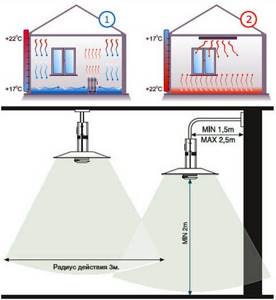
Towards the principle of infrared heating from above
How is this achieved? Due to heat distribution similar to underfloor heating, see fig. The comfortable zone is where people are, and heat loss through the ceiling is sharply reduced, which is especially noticeable in one-story houses. Plus, the floor can be insulated from the inside; the flow of heat from above will prevent the dew point from entering the room.
But, unlike a heated floor, complex construction work is not needed, there is no thin winding tube embedded in the floor that can become clogged or leak (how can you repair it without breaking the floor?) Unlike electric heating, it is not expensive electricity that heats, but gas, a unit of energy is several times cheaper. Another plus is that the flow of warm air from the heated infrared floor is uniform over the area of the room; the inhabitants live as if on a warm island with an even climate.
GII device
GII burners are open type devices. In them, the gas-air mixture is blown through narrow channels in microdoses; air is sucked in naturally without pressurization. In ceramic GIIs (diagram in Fig. yb;t), nozzle channels are made in a ceramic (usually carbon) plate, which itself heats up to 900 degrees. Due to the high temperature in the microcombustion chambers, the efficiency of the device exceeds 90%, and 70-75% of the gas energy is converted into infrared radiation.
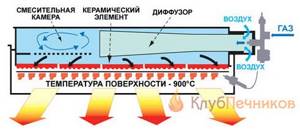
Diagram of a ceramic gas infrared burner
In catalytic GII burners, the combustible mixture passes through a catalyst mesh. The combustion catalyst itself is either platinum coating (eternal, but expensive), or nickel coating with additives (cheaper, but gradually burns out). Anyone who has used a wind-resistant gas lighter is familiar with catalytic combustion.
Ceramic GIIs are cheaper than catalytic ones, but their power is limited to 12-15 kW, because It is difficult to make the flow of the mixture through narrow nozzles very intense. The dimensions of ceramic GIIs cannot be very small; For effective radiation, a fairly large plate area is needed. Catalytic GIIs with power up to 30 kW and more weigh several kg; they can be made miniature, but are expensive.
Open GII in residential premises is of limited use, because emit carbon dioxide, although in small quantities. In practice, if there is supply and exhaust ventilation for 2 air changes per hour, open HII with a power of up to 12 kW can be used for temporary heating under constant supervision.
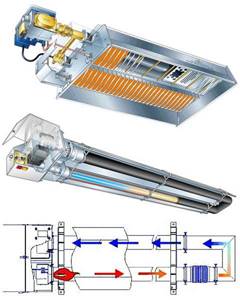
Gas infrared emitter device
GII emitters, or gas heating elements (diagram in Fig.) do not have this drawback, and therefore can be used for constant heating of residential premises. They require pressurization, therefore they are energy dependent, but, on the other hand, any modern gas hot water boiler is also energy dependent. And one and a half hundred years ago, pipelines for gas lighting were stretched like a web throughout the houses, and there were no widespread emergencies, although the gasification technology then was compared to the current cave technology.
The first to go on sale were open ceramic GIIs for temporary heating of garages and outbuildings, pos. 1 in Fig. Probably, it was the need to create a comfort dome in a room with large heat losses, without burning exorbitant amounts of fuel, that prompted the creators of the first GII to develop them.
GIIs for garages are successfully used to this day: sellers offer them in a wide range, and prices have dropped from 800 to 90-150 USD in 7 years; Certification and a separate permit for the operation of garage GII are not required. In everyday life, ceramic GIIs have also found application for replacing electric fireplaces, pos.

Gas infrared heaters
GIIs, as powerful, relatively inexpensive, reliable and energy-independent heat sources, immediately attracted the attention of participants in field and expeditionary work, hunters, fishermen, tourists, yachtsmen and others who faced the problem of heating far from civilization. But these categories of users required a large specific power in relation to their weight and size, so they gave preference to catalytic GIIs.
The first samples (item 3) were similar to their non-catalytic counterparts. In the end, the “suburban” branch of the evolution of GII gave birth to a gas mini-oven (fig. on the right), which can be carried with you while moving on foot. However, there are few of them on sale: they are expensive, from 200 USD, and refueling requires expensive lighter gas.
Gas mini oven
The development of GII towards constant heating turned out to be much more productive. The high specific power of the GII, now per unit of radiating surface, made it possible to organize warm islands directly in the open air; for this it was only necessary to assemble the radiating panels under the reflective umbrella and place it on a stand, pos. 4.
The efficiency and cost-effectiveness of heating with GII “umbrellas” turned out to be so high that the question arose about using them for permanent heating of housing. At this time, the heated floors were wide open; their sanitary and hygienic properties were not in doubt, but the issue of complexity of installation in existing buildings and maintainability became acute.
You already know the solution: GII burners were replaced with gas heating elements, and the umbrellas were removed from the stands and hung directly from the ceiling. Here, a large reflector is not really needed, and ceiling GII emitters are often made in the form of flat panels; in multi-storey buildings on floors below the topmost, the overall efficiency does not noticeably deteriorate from this.
Heat gas gun
Heat gas guns are distinguished by their high power and high level of energy output. Usually the structure is equipped with a chimney.
To make such a device yourself, you will need the following materials:
- meter pipe with a diameter of 18 cm;
- meter pipe with a diameter of 8 cm;
- pipe 30 cm long and 8 cm in diameter;
- metal plates for future fastening;
- a metal sheet;
- gas burner equipped with piezo ignition;
- axial fan with round flange.
In addition to the materials listed, you will additionally need to acquire a welding machine, a tape measure and a level with two ampoules. Some craftsmen advise using old gas cylinders or fire extinguishers instead of pipes. Their bottom and top are first carefully cut off with a grinder.
If you collect all the necessary materials and tools, then assembling a gas gun will not take much time.
The first step is to drill two holes in the first pipe with a diameter of 18 cm. They should be located opposite each other, and their diameters are 1 cm and 8 cm. The second meter pipe with a diameter of 8 cm is used to make the combustion chamber. For this purpose you will need about 30 cm.

The essence of the operation of a thermal gas gun is as follows. First, the gas supply to the burner starts. The fan moves air through the heat exchanger, where it heats up. The output is warm air, which very effectively heats large rooms.
The mounting plates must be welded to the second pipe. A hole with a diameter of 1 cm is also made on this pipe. After this, the pipe must be inserted inside the first pipe.
The next step is cutting out a plug from a metal sheet, which will be used to cover the space between the heat gun frame and the combustion chamber.
Then you should use a welding machine and weld the pipe from which the combustion chamber will be made to the internal frame. After this, a pipe through which hot air will be exhausted is welded to a hole with a diameter of 8 cm. Next, a plug is welded.
The gas burner must be firmly and firmly installed in the chamber. It is necessary to check the rigidity of the fastening. After this, a hose is passed through the drilled centimeter holes in the two pipes. Then a fan heater is attached to the heat gun. A chimney must be installed on the front of the chamber.
To prevent the device from turning over and to stand stably on a flat surface, you need to weld the legs. You can also use your imagination and attach wheels or other parts to make the structure easier to transport.
Heating a room with a heat gas gun is convenient and simple. Moreover, it is economical. However, there is always a risk of structural failure. Therefore, you should be very careful and thoughtful in the process of assembling the device.
Gas in cooking
Gas baking oven
The next area where gasification of ovens is not only useful, but simply necessary is culinary and technological equipment. A gas baking oven, for example, takes up only about 10 square meters. m of ordinary, non-production space and without requiring an industrial supply of gas and electricity, allows you to bake up to 100-200 loaves of bread at a time, see fig.
The second culinary device where gas is more than welcome is the pizza oven. Already a household tabletop (left position in the figure on the right) produces a product that even an unpretentious eater immediately distinguishes for the better from one baked with an electric grill. In this case, the role played by the greater heat flux density generated by the gas compared to the electric one.

Gas pizza ovens
A completely unexpected result was achieved by gasification of the traditional Pompeian pizza oven, right pos. Inveterate gourmets cannot distinguish the taste of real noble pizza from a wood-burning or gasified Pompeian oven. But the productivity of the unit (and the income of restaurateurs) has increased by almost one and a half times.
Portable tile heater
Small rooms, a garage, a greenhouse, a tent can be conveniently heated with a portable tabletop gas heater. Such a device is constructed from a quadrangular flat tile equipped with a metal grid.
Assembling this device involves attaching part of the gas stove to a metal casing. Due to the installed combustion chamber, the air is heated to the desired temperature, and several or one fan ensures the supply of warm air and its circulation throughout the room. The assembly of such a device consists of several stages and does not require special technical knowledge.

The first stage is working with measuring tools. You need to use a ruler or tape measure to take accurate measurements from the quadrangular tile. This will be required to determine the parameters of the heater housing. After taking measurements, you need to cut out blanks from a tin sheet using scissors. Next, the blanks are fastened with rivets into a casing.
Then the casing is fixed with hook strips on the tile. In order for it to be quickly removed and mounted back, you need to make a movable bar. Such a bar can be easily made using a small spring, which is connected to a lifting lever.
Thanks to this solution, in the future it will be possible to easily remove the casing for cleaning or transportation. The homemade scheme under consideration assumes the presence of a special ventilation system. To install it you will need a simple fan without any additional complex devices or materials.
A small fan from any home device is suitable for installing ventilation. You can use scissors to adjust the size. Trimming and giving the desired shape and size to the fan blades takes about half an hour. After carrying out these steps, you need to install a ready-made fan behind the heater housing so that there is draft inside the housing.
You also need to install a metal combustion chamber. The combustion chamber body must be studded with many small holes. They can be made using an electric drill and a metal drill or using a hammer and nail. The holes should be a short distance from each other.
You also need to purchase a rubber hose with an adapter to connect the flat tile to a gas pipe or gas cylinder. A fan installed at the rear of the casing ensures the supply and distribution of warm air over a fairly wide range in the heated space.

Such a homemade gas heater copes well with the task of heating a room not only in the autumn-spring period, but even in winter. Also, such a device consumes gas economically and has a high efficiency.
Classification
Today, there are a number of various modifications of hearth gas ovens, used both for cauldrons and for baking bread, which can easily compete with an electric oven. Therefore, in order to determine the most suitable model, it is necessary to clearly define the necessary parameters on which future work will be based.
Gas furnaces can be divided into three types:
- heating systems, intended for heating and used in private households;
- heating units designed to provide hot water supply;
- household, intended for cauldrons, baking bread and heating large areas.
For example, for a bathhouse, it is better to install a heating heating system, which can have different cladding options, type of burner, as well as technology and method of heating the water available in the bathhouse. It is not safe to use an electric stove.
Gas furnaces are divided by area of application into:
- heating;
- heating;
- household
The latter are intended for cooking; heating ones are used in homes and hot water supply.
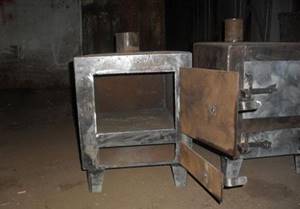
Heating ones are well suited for baths, since they are able to work at high humidity and produce high temperatures.
How to choose a heating system
A private house or cottage must be fully heated to make it comfortable to stay in at any time of the year. To choose the appropriate heating system option, you can read reviews, literature and seek advice from specialists.
Gas stoves are often used for home use. They require natural gas to operate. Such devices consist of a foundation, a body and a chimney. The body is usually made of brick and consists of elements such as a firebox, a gas burner, and a heating panel (read: “Heating panel - making your own”).
If there is no centralized heating system, then a gas stove for the house can be installed, but only if it has no more than two floors. Such equipment can operate in both temporary and permanent modes. In the firebox of the furnace there is a gas burner, in which the combustion of fuel occurs. At the top of the firebox there is a grate made of heat-resistant brick.
During the operation of a gas furnace, the grate is heated, and the heat flows to the walls of the firebox. This ensures uniform heating of the air. If you install gas burners in the firebox at the lower level, the lower masonry of the stove will warm up more efficiently, and accordingly, the volume of the firebox will be used more wisely.
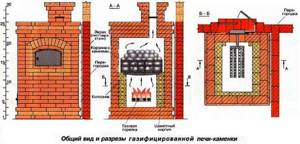
The firebox of a gas furnace in the upper part borders on the chimneys, and in the lower part it communicates with the blowers. Through this element, air enters gas stoves for the home, without which combustion of fuel becomes impossible.
There is a small hole in the ash door for switching the stove to gas. If the operation of the device is not constant, then it is necessary to build a firebox from refractory bricks. A red brick firebox can only be made if the stove will operate year-round. Stove flues must be installed in a shield (pro
Gas in the workshop
Gas heating stove from a tin can
The high achievable temperature and the absence of chemically aggressive substances in combustion products make the gas flame very attractive for home craftsmen. You don’t need much here: a heating furnace for heating small metal parts is made from... an empty tin can, see fig. Just remember to leave a gap at the bottom for air access!
Small-sized muffle and melting furnaces on gas, incl. desktop ones are also available for sale. But a home-made worker or self-employed individual entrepreneur will have to be disappointed here: the fire department and gas service do not issue permits to individuals to operate them. And for legal entities - only those provided with appropriately equipped production space. So in unsuitable rooms you will have to make do with electric stoves.
How to increase efficiency
A potbelly stove made from a gas cylinder is a very gluttonous creature.
But if you install an adjustment window and make all joints sealed, then fuel consumption will be reasonable.
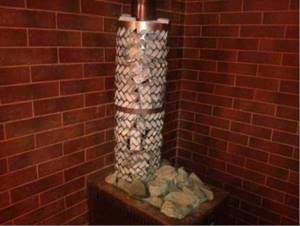
You can increase the efficiency of a potbelly stove from a cylinder by installing additional screens on the sides of the body. Another option, to increase the heat capacity of a stove from a gas cylinder, is to install a metal mesh around the body and chimney pipe, into which stones are placed according to the heater principle.
About gas fireplaces
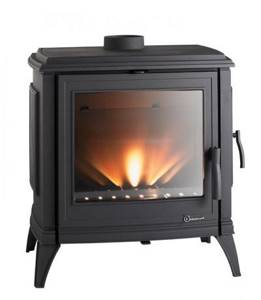
The remarkable properties of natural gas have given rise to attempts to make a gas stove-fireplace. However, they cannot be considered successful: the blue light is beautiful in its own way, but it is still not a living flame. Manufacturers, being clever with burners, sometimes create something similar to it, supposedly in a modern style, see the figure on the right. However, the psychological and aesthetic significance of the fireplace traces its ancestry to a well-fed primitive tribe in a cave around a fire after a successful hunt, and without chaotically dancing tongues of fire, a fireplace is not a fireplace.
Principle of operation
The walls of the fuel cell are heated by combustion of fuel. Air, to support the combustion process, is supplied through the ash pan.
At the top of the heating device there is a chimney (combustion products exit through it), it is connected to the firebox.
Water circuits are rarely connected to gas stoves. The room is heated directly by heated air from the stove. The only difference with a solid fuel stove is that natural gas is used, not wood.
There are options for gas stoves combined with a solid fuel unit or powered by electricity. There are universal burners that run on diesel fuel if the need arises.
Features of gasification of a bath
Russian government decree No. 509 of 2008 states that gasification of a bathhouse is allowed. The only condition is that its use for commercial purposes is prohibited.
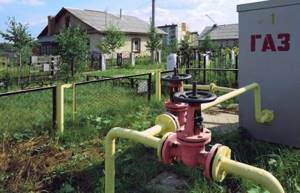
If the boiler is equipped with an atmospheric burner, the inspector will check the ventilation device and draft
The project should include:
- the presence of a separate entrance (heat-resistant materials are used to make the door);
- availability of fire extinguishing and alarm systems;
- the equipment must be industrially produced and have a quality certificate;
- It is mandatory to have a ventilation system and a carbon monoxide detector.
Practice shows that the chance of obtaining permission to gasify a bathhouse increases if all work is carried out by specialists competently and efficiently. After the building of a bathhouse or sauna is built, it should be registered with the BTI. The next stage is a trip to the city gas supply office, where an application for gasification is written.
When the application is reviewed, an inspector will visit the gasification site. As a result of the inspection, changes may be required (installation of additional ventilation, alteration of the chimney). When permission is received, all that remains is to connect the equipment and insulate the bathhouse building.
After selecting and installing a gas boiler in the bathhouse, you can enjoy the result of your labor. Money and time costs are compensated by maximum comfort and safety. After all, modern equipment allows you to create an optimal balance between temperature and humidity, does not dry out the air and is ideal for lovers of a traditional bath.
